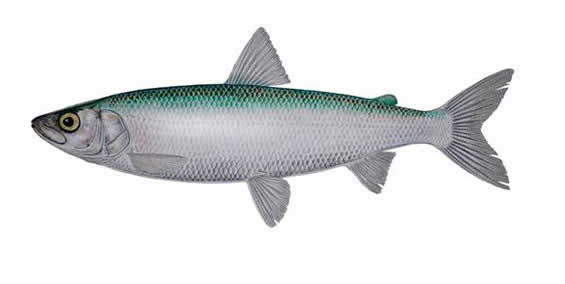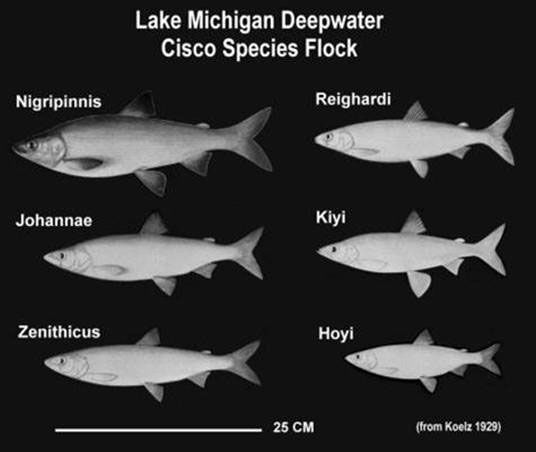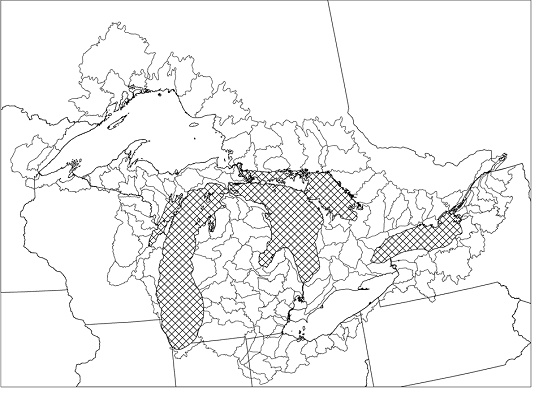Recovery Strategy for the Shortnose Cisco in Canada [Proposed]: Species Information
Date of Assessment: May 2005
Common Name: Shortnose Cisco
Scientific Name: Coregonus reighardi
COSEWIC Status: Endangered
Reason for Designation: Endemic to three of the Great Lakes, this species was last recorded in Lake Michigan in 1982, in Lake Huron in 1985, and in Lake Ontario in 1964. Although it has probably disappeared throughout its range, searches for this species have not been extensive enough to declare the species extinct. The species' apparent demise is suspected to be the result of commercial overfishing and possibly competition or predation from introduced species.
Canadian Occurrence: Ontario
COSEWIC Status History: Designated Threatened in April 1987. Status re-examined and designated Endangered in May 2005. Last assessment based on an updated status report.
The Shortnose Cisco was formerly assessed as “Threatened” by COSEWIC in 1987 based on a status report by Parker (1988). In 2005, COSEWIC reassessed the species as Endangered based on an update status report (COSEWIC 2005), and the species was formally listed as such under Canada's Species at Risk Act in 2007. The species is also listed as Endangered under Ontario's Endangered Species Act, 2007. NatureServe (2009) ranks the species as Globally Historic (GH) and Nationally Historic (NH) in both Canada and the USA as well as Regionally Extirpated (SX) in Illinois, Indiana, New York, and Wisconsin, and Regionally Historic (SH) in Michigan and Ontario. The Shortnose Cisco is included on the IUCN Red List under the category of Critically Endangered (Gimenez Dixon 1996) and has been assessed as Endangered by the American Fisheries Society (Jelks et al. 2008). As there are no known extant populations throughout its historical distribution in lakes Michigan, Huron or Ontario and the last reported sighting for the species was from Lake Huron in 1985 (Webb and Todd 1995) the Shortnose Cisco is thought to be extinct (COSEWIC 2005, Jelks et al. 2008, Mandrak and Cudmore 2010).
The Shortnose Cisco (Coregonus reighardi) (Figure 1) belongs to a taxonomically complex group of closely related cisco forms representing a “species flock” (Figure 2) which was endemic to the Great Lakes of North America (Smith and Todd 1984; Todd and Smith 1992; Scott and Crossman 1998, Cudmore-Vokey and Crossman 2000). The species was typically characterized by a cylindrical body, short head, short snout with terminal mouth, small eye, black pigmentation around the snout, short paired fins and low gill raker count (typically 32-42) (Pritchard 1931, Jobes 1943, Scott and Crossman 1998). Koelz (1929) reported the occurrence of two forms of Shortnose Cisco occurring in the Great Lakes: Coregonus reighardi reighardi from lakes Huron, Michigan and Ontario; and, Coregonus reighardi dymondi from lakes Superior and Nipigon. Subsequent review of the morphological variations and systematics of the species led to C. reighardi dymondi being synonymized with the Shortjaw Cisco (Coregonus zenithicus) (Todd 1980, Todd and Smith 1980, Parker 1988). Consequently, C. reighardi is now regarded to have occurred only in lakes Huron, Michigan and Ontario (COSEWIC 2005). As with other deepwater ciscoes occurring in the Great Lakes, overexploitation, ecosystem impairment, and possible hybridization may have contributed to the eventual collapse and extirpation of the species (Smith 1964). Hybridization within deepwater ciscoes was suspected as early as 1960; at which time specimens collected were noted to almost defy placement within any species category and were sometimes referred to as “hybrid chubs” (Smith 1964). Confusion over its taxonomy and identification may be reflected in some of the data available for the species.
Figure 1. The Shortnose Cisco (Coregonus reighardi Koelz) (Illustration by Paul Vecsei, 2011)

Description of Figure 1
Little is known of the biology of the Shortnose Cisco (Parker 1988; Scott and Crossman 1998; COSEWIC 2005). It was one of the smaller deepwater cisco or “chub” species indigenous to the Great Lakes. Todd (1980) reported adult size generally ranging 170-260mm standard length (SL), although fish of at least 356mm SL and weights of 539g were reported from Lake Ontario (Scott and Crossman 1998). It was the only known spring-spawning cisco species in the lakes where it occurred. Spawning reportedly occurred between April and May in Lake Ontario and between May and June in lakes Huron and Michigan at depths of 52m - 146m (COSEWIC 2005). There was some evidence that late fall spawning might also have occurred (Koelz 1929; Smith 1964), potentially allowing for hybridization with other fall spawning species (Scott and Crossman 1998). Information on fecundity, embryological development and early life history is unknown (Parker 1988).
Figure 2. Lake Michigan deepwater cisco species flock including the Shortnose Cisco. From Koelz (1929)

Description of Figure 2
Shortnose Cisco occurred only in the Great Lakes within lakes Michigan, Huron, and Ontario (Figure 3). The species was last reported from: Lake Ontario in 1964; Lake Michigan in 1982; and, the Georgian Bay area of Lake Huron in 1985 (COSEWIC 2005). The species has not been reported since then despite significant fishing and sampling efforts. Although the occurrence of any remnant populations cannot be ruled out, it is very unlikely (Webb and Todd 1995, COSEWIC 2005, Mandrak and Cudmore 2010).
Figure 3. Global historic distribution of Shortnose Cisco (Coregonus reighardi). From COSEWIC 2005.

Description of Figure 3
The species was once a valuable component to the commercial “chub” fisheries which started in earnest in the mid to late 1800's but began showing signs of depletion by the early 1900's (Koelz 1926, Jobes 1943). Landed “chub” catches were rarely identified to individual species and few collections were made to evaluate population sizes and trends. Only 324 specimens were documented from Lake Huron with a single specimen collected in 1919 and the balance collected between 1956 and 1985 (Webb and Todd 1995). Misrepresentation of the Shortjaw Cisco as the Shortnose Cisco in lakes Superior and Nipigon prior to 1980 may have obscured the critical status of the species elsewhere in the Great Lakes.
Although distribution data for the species are lacking, deepwater habitats within lakes Huron and Ontario were abundant. Based on a suitable depth stratum of 35m to 100m, roughly 47% of the total area of Lake Huron (60,166 km²) and 26% of the total area of Lake Ontario (24,157 km²) would have been suitable habitat for the Shortnose Cisco (COSEWIC 2005).
The Shortnose Cisco occurred in clear, cold, deepwater habitats in lakes Huron, Michigan and Ontario ranging in depths from 22m to 110m (COSEWIC 2005). Its diet consisted primarily of the freshwater crustaceans Mysis diluviana (formerly Mysis relicta) and Diporeia spp. along with small numbers of copepods, aquatic insect larvae, and fingernail clams (Scott and Crossman, 1998). Spawning was believed to occur primarily during April through June at depths in excess of 52m (COSEWIC 2005).
Page details
- Date modified: